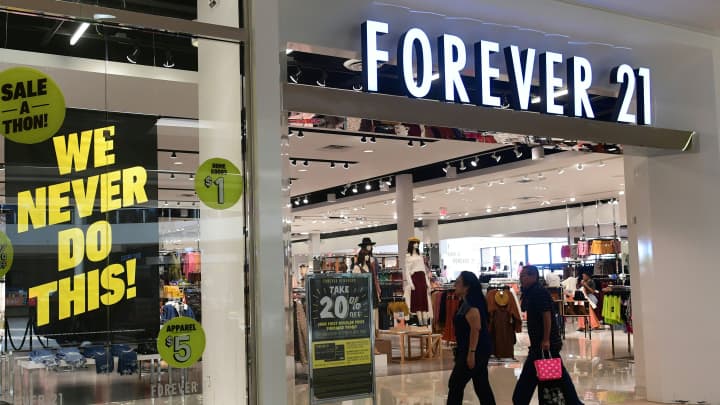Founded in 1984 by South Korean immigrants Do Won Chang and Jin Sook Chang, Forever 21 catered to Korean Americans in Los Angeles but rapidly expanded to several countries. Changing their brand name from Fashion 21 to the now Forever 21, they transformed the fashion industry with their fast-fashion business model. While they originally sold fashion inspired by South Korean fashion trends, their rapid change required something fresh, where their fast fashion began to thrive. However, was this exact change their downfall?

Nowadays, Forever 21 is synonymous with “being cheap,” and the company has faced immense criticism for its poor labour practices. Moreover, their lack of sustainability has garnered criticism, especially among younger shoppers who are more conscious about which brands practise sustainable fashion. Forever 21 also failed to anticipate the “retail apocalypse,” underestimating the rise of e-commerce and facing an avoidable financial crisis.
Where Did It All Go Wrong?

Investing in Big Stores in Big Spaces
In a mere 6 years, Forever 21 expanded from 7 countries to 47. However, while most retail stores focused on downsizing, Forever 21 did not get the memo and kept their unnecessarily large stores. The larger the scale, the more the rent. Forever 21 couldn’t realistically afford all of these stores, especially knowing that the largest one is 162,000 square feet in size and multiple stories tall. Their sales went down by 25%, which indicates that their large stores in expensive areas cost them a lot of money. Affording rent and operational costs for them subsequently led them to bankruptcy. They now have to close down more than 350 of their stores worldwide.
Fast Fashion’s Lack of Sustainability
Forever 21 was the pinnacle of fast fashion, costing them more than they could ever predict. Fast fashion contributes to at least 20% of wastewater and 10% of global carbon emissions. How does it contribute, you ask? The synthetic material of these trendy clothes, as well as the quick manufacturing process, leads to consumers quickly throwing away the cheap products. Thus, fast fashion is almost guaranteed to be a wasteful item and harmful to the environment. Forever 21 failed to understand consumer sentiment towards the climate crisis and kept mass-producing fast fashion. A company must always evolve with consumer feedback and trends.
Failing to Adapt to E-Commerce
The rise of e-commerce is another customer preference that Forever 21 failed to capitalise on. By the time they caught up to the e-commerce game, other famous brands like ASOS and Myntra were already on the rise with their easy returns and fast delivery. Forever 21 couldn’t perfectly align itself with younger customers anymore, especially with those from other countries such as China or India.
Is It Trendsetting If It’s Cringe?
It’s undeniable that Forever 21 thrived in the 2000s, especially with their target 21-year-old customer base. Everyone went to Forever 21 for the latest fashion trends and the affordable price. When it entered the Indian market, customers were flooding their expansive stores. However, with their fame came their downfall. As all trends do, they die. Forever 21 did not get that memo. Their fashion usually includes a normal-looking piece of clothing ruined by ridiculous quotes. It’s become a huge meme amongst shoppers who find something they like at Forever 21, only to turn it around and find it has a weird quote at the back. Customers eventually got tired of trying to find something that would be presentable and fashionable for the times. Forever 21, once again, did not listen to their customers.
How Can a Business Learn From Forever 21’s Demise?

Analyse Customer Trends
As seen by most of the factors that led to their downfall, Forever 21 consistently ignored consumer trends and sentiments. Brands should always be conscious of what consumers want first and accept criticism as a step forward. It’s an important step in maintaining the trust of your customer base, a factor that will make your brand thrive. If you observe that the majority of your customers are dissatisfied with the design choices, better designs should be created. Similarly, a concern as grave as the climate crisis has to be addressed, and solutions for sustainable operations should be integrated immediately. Ethical practices have become a top priority among young shoppers nowadays.
Keep Your Enemies Closer
Keeping track of your competition is one of the most important aspects of running a successful business. Forever 21 lost the competition when they did not put any emphasis on online shopping, sticking to the brick-and-mortar stores that cost them gravely, did not meet consumer expectations, and overall, became outdated and bankrupt. However, if you actively monitor what your competitors are doing right and what mistakes they make, too, your brand can learn and do better.
Reduce Operational Costs and Prevent Further Losses
Despite consumers preferring online shopping and empty shopping malls, Forever 21 built more stores in premier locations and malls. A brand should always be aware of their spending habits and cut down costs wherever possible. Keeping an eye on the market direction will promote better profit and avoid any overhead costs.


